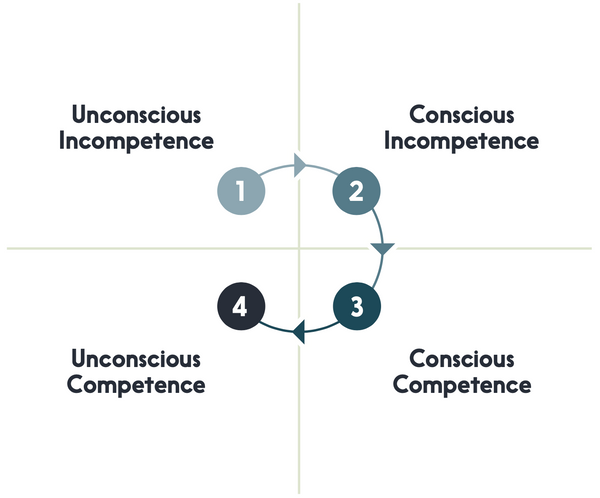The Conscious Competence Model
By Hans Jensen

A large part of preparing to write PracticeMind: The Complete Practice Model with co-author Oleksander Mycyk involved reading a wide variety of books and studies about practicing, learning, and developing motor skills. Combining the experience and knowledge we gained from years of teaching and performing with these latest research materials helped reinforce and develop the ideas about learning and mastery that we present in the book.
When I first saw the Conscious Competence Model described in the book: The Dynamics of Life Skills Coaching I was immediately struck by how well the four different stages of learning in this model align with my own experience in learning and teaching a musical instrument. For a teacher or student to really understand how these four stages work is extremely helpful for teaching, practicing, and learning and mastering new skills. As a younger teacher I often felt overwhelmed when students were stuck at the initial Unconscious Incompetence stage of the system. At that time, it was not totally clear to me exactly what was going on with the student or how to move forward. I wish that I had been exposed to this model many years ago as it would have saved me from many hours of worrying about the development of many students.
Here is short excerpt taken from PracticeMind: The Complete Practice Model by Hans Jensen and Oleksander Mycyk that explains this illuminating process.
The Conscious Competence Model
The conscious competence model developed by Noel Burch in the 1970s is an effective way of explaining the four mental stages we all go through when learning something new. Within this model, a learner starts at the unconscious incompetence level and passes through conscious incompetence and conscious competence before finally arriving at unconscious competence.

- Unconscious incompetence
In the first stage of the conscious competence model—unconscious incompetence—the skill cannot be performed, and the player has a lack of knowledge relating to their own deficiencies or problems addressing this specific skill. The amount of time a player spends within this stage depends on stimulus or feedback from another person, such as a teacher or colleague.
- Most of the time students waste while practicing takes place in this state of unconscious incompetence. They spend a tremendous amount of time and energy practicing but lack a clear goal for exactly what they are trying to accomplish. Additionally, they don’t realize that they don’t have a clear goal. Students in this stage often become upset and frustrated because they are trying hard but don’t see many results.
- Conscious incompetence
At the conscious incompetence stage, the skill still cannot yet be performed, but the player at least understands the problems that prevent their successful performance. Observing and understanding these problems is an integral part of improving the practice process at this stage.
- Ineffective practice is strongly related to practicing without a clear plan. To correct this issue, students use their awareness of their deficiencies to form a more effective practice plan. One strategy might be to record a practice session at this stage and then observe how some elements of practicing might be too random and lack a clear implementation of an organized plan of action. Observing how much time and effort is wasted can be a wake-up call that it’s time to move on.
- Conscious competence
In this stage, the new skill has been learned but is not yet automatic. When practicing, the player must still use a fair amount of self-conscious concentration to perform the skill.
- Having developed conscious competence, students start to organize their practice sessions around knowledge of what is good and bad while using organized methods of problem solving to progress in their learning.
- Unconscious competence
In the final stage of learning, the player achieves the desirable state of unconscious competence whereby the skill can be performed without considerable conscious thought. It is within this stage that freedom of expression is possible, as the conscious mind is no longer hindered by thinking about the mechanics of performance.
- For students, this stage of learning forms a strong foundation for developing highly artistic interpretations and reaching the next level of technical and musical mastery.
Epilogue - Final thoughts about the learning process
Over the years I have experienced students working at all four stages of learning. It is important to point out to students who are stuck at stage one that no amount of practicing will help them improve and move on in their journey towards a better level of playing unless they understand the learning process better and move on to stage II: Conscious Incompetence.
It is also so important for students to understand that once a skill is learned and mastered it requires unconscious competence. Once we understand the learning process it is imperative that we let go of consciously thinking about what we do when performing and playing at the highest level. Understanding that thinking consciously about what we do can get in the way of playing and performing to our best ability should be an encouragement towards developing the ability of letting go. If the skill or specific technique is not working unconsciously, more practicing must take place at stage 3 and sometimes it is even helpful starting again at stage 2.
I hope that you will spend some time understanding this model because I am sure it will be helpful for you. In my own teaching, it clarified and crystalized the distinct stages of the learning process. Happy teaching and happy practicing.
